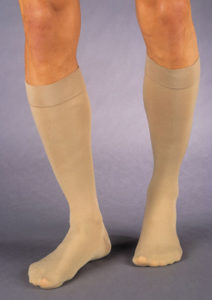 Who needs Compression stockings?
Who needs Compression stockings?
Compression stockings are recommended for anyone who’s had a significant DVT, one that’s made their leg swell and damaged the valves in their deep veins.
Why are they needed?
The medical reason for recommending compression stockings is because they help prevent post-thrombotic syndrome. However, some people wear them because of the help they offer with pain and swelling in the leg.
How do they work?
In undamaged legs, when the muscles contract, they squeeze the veins almost shut and deoxygenated blood is pushed forwards to your heart. Valves in the leg veins stop blood flowing backwards.
After a DVT the valves can be damaged and blood flow from the legs is poor leading to a higher pressure in the veins due to some back flow. This means that deoxygenated blood pools in the veins, causing aching, swollen legs and over time damaging the skin. When this becomes severe, it’s called post-thrombotic syndrome.
Compression stockings squeeze the blood out of the superficial veins of your legs. This increases the blood flow through your deep veins and tends to decrease pooling. They don’t work by squeezing the deep vessels as you might have expected, because the deep vessels are protected by a lot of muscle.
It’s the action on the superficial veins below your knee that has most impact on blood flow so below knee stockings are all that’s needed, even if people have had an above knee clot.
How long do people need them?
The usual advice is to wear them for two years after a DVT. Tomorrow, we’ll be covering an article just published in the BMJ , that compared wearing them for 12 months or 24 months and the incidence of post-thrombotic syndrome.
What’s the difference between these and flight socks?
Grade 2 or 3 compression stockings are used post DVT. These have a pressure of 20 – 40 mm of mercury rather than the less tight flight socks.
Compression stockings should be specially fitted with measurements taken of your ankle and calf and distance from knee to ankle. They offer graduated compression being tightest around the ankle and gradually diminishing as you go up the leg. The band at the top should be loose enough not to cause a mark.
Compression stockings are available from fewer places than flight socks. They cost more, in part because they need higher quality materials, and unfortunately they are not funded in New Zealand so rather than getting a prescription, you have to pay for them yourself.
Flight socks won’t prevent post-thrombotic syndrome.
Are there any potential problems?
It’s really important to be sure people have adequate blood flow to their legs before prescribing compression stockings. People with arterial disease, for example those with angina or intermittent claudication (pain in the calves on walking) may develop cold, painful legs with ulcers if they use compression stockings.
Stockings must be removed each night (some people have such problems getting them on that they’re then tempted to leave them on for a while) as otherwise pressure sores can form.
What about practicalities?
You need to put them on first thing, preferably before you get out of bed (When I read this advice, I assumed it was for people who don’t take baths or showers!) and keep them on until bedtime.
You need to have them fitting properly, as folds can rub and lead to ulcers.
You need to find a way to get your toes in then wiggle them up your leg, without pulling just from the top, which can lead to stretching or tearing of the fabric. Maybe use talcum powder or funny metal contraptions like they use for bandaging in emergency departments. (Here’s a video of one being used by someone who really doesn’t look like she needs compression stockings!)
Like most things, you’ll get better with practice. The aim is to make it part of your everyday routine.
Do you manage to use compression stockings as advised? or have you had any issues?

Hello again and thank you Paul. Taking warfarin does not inhibit my normal activities in any way and I feel very thankful that really the only side effects are to do with bleeding. I am simply careful when it comes to foods that may affect its action and, for example, extra careful around sharp implements!
The only problem I have is to do with leg support. After wearing compression stockings I went on to wear ordinary medium support stockings. These helped a great deal with swelling and aching. However just over a year ago I developed patches of quite severe eczema on both lower legs. Although this is now well controlled I am afraid that the support stockings irritate my skin. Hence I no longer wear them and just put up with the swelling and a bit of aching. I do elevate my feet when sitting down and I do get a fair bit of exercise. I wonder if you can suggest anything else I might do? Thanks.